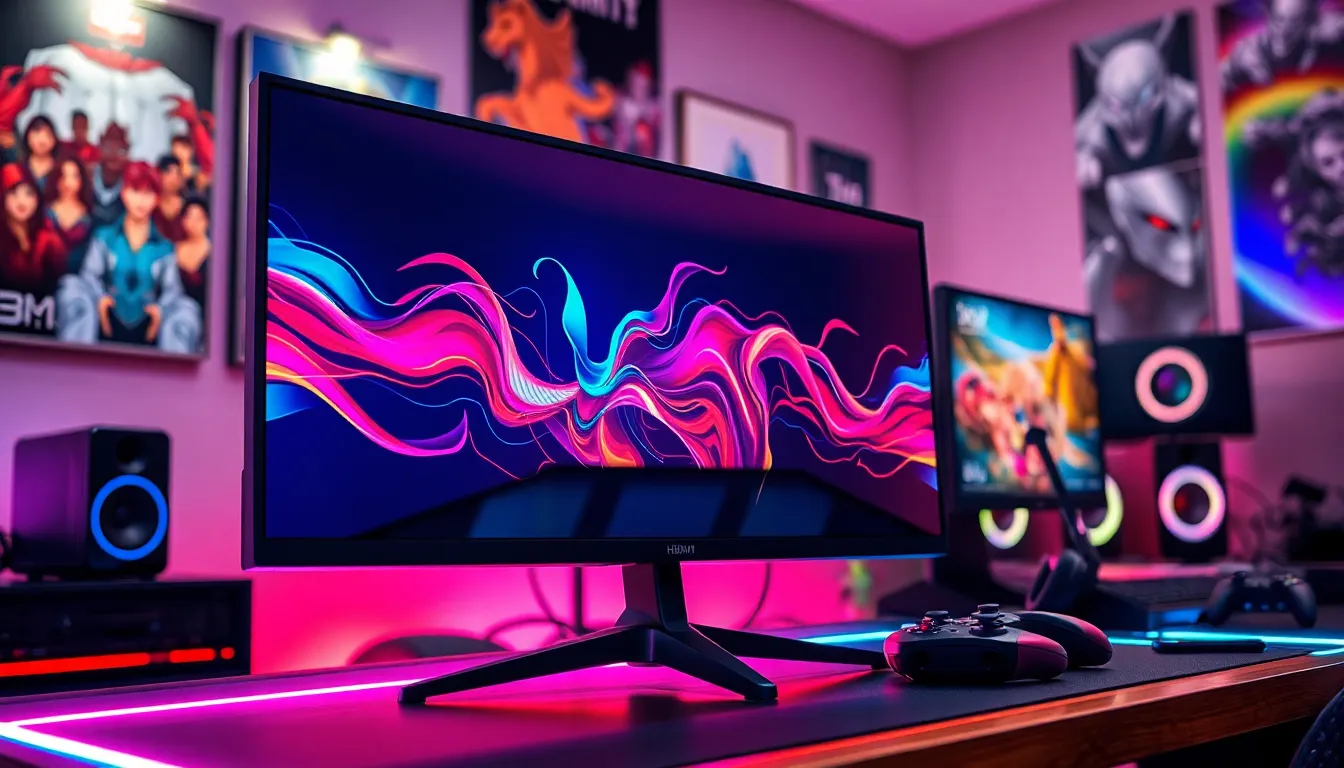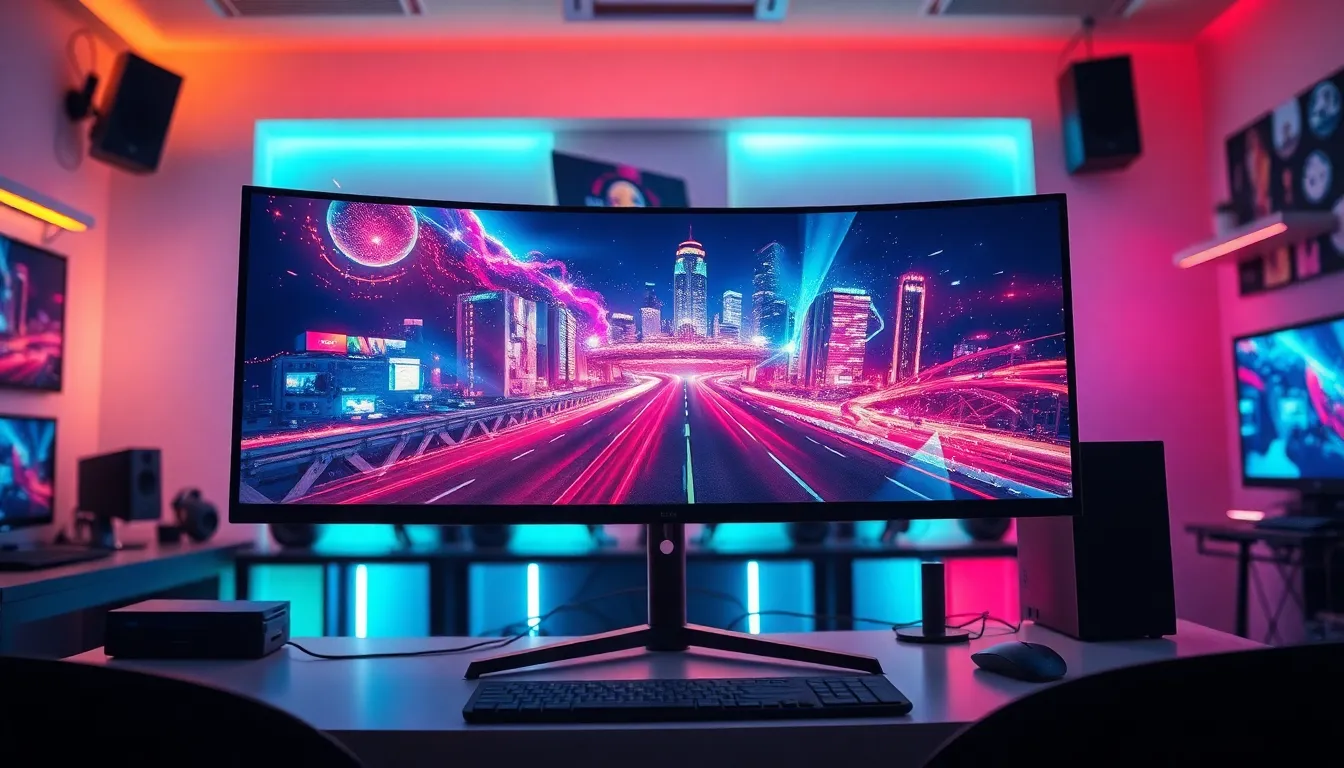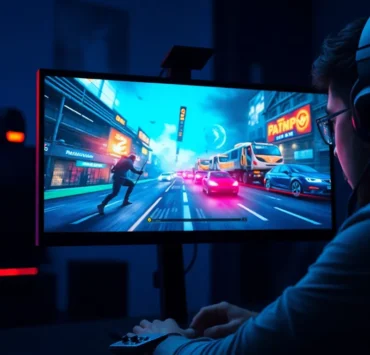In the fast-paced world of gaming, the right monitor can make or break the experience. Enter HDMI 2.1—this tech marvel is like the secret sauce for gamers craving ultra-smooth visuals and lightning-fast response times. Imagine diving into your favorite game with stunning graphics and zero lag. It’s like having a cheat code for your setup!
Table of Contents
ToggleGaming Monitors With HDMI 2.1
Gaming monitors featuring HDMI 2.1 technology revolutionize the gaming experience by delivering exceptional performance. These monitors support resolutions up to 8K at 60Hz and 4K at 120Hz, providing users with the ability to enjoy incredibly smooth visuals. Fast refresh rates reduce motion blur, allowing gamers to see details clearly during high-speed action.
Gamers can take advantage of Variable Refresh Rate (VRR) and Auto Low Latency Mode (ALLM), which enhance responsiveness during gameplay. These features synchronize the refresh rate with the game’s frame rate, ensuring minimal lag and improved gameplay fluidity. Additionally, HDMI 2.1 supports advanced features such as Dynamic HDR, making colors more vibrant and contrast deeper.
Key specifications distinguish HDMI 2.1 monitors from their predecessors. They typically include features like 10-bit color depth and enhanced audio return channels (eARC), which allow for high-quality audio transmission. Many models also come equipped with Display Stream Compression (DSC), enabling seamless handling of 8K content without sacrificing quality.
When choosing a monitor, consider screen size as an essential factor. Large screens, often ranging from 27 to 49 inches, provide an immersive experience, particularly in action-heavy games. Manufacturers are increasingly focusing on low input lag and high response times, optimizing these monitors for competitive gaming.
Certain brands stand out for offering HDMI 2.1 monitors designed to cater to serious gamers. Companies like ASUS, LG, and Samsung have established themselves with high-end models packed with features that maximize gaming performance. These displays ensure that gamers stay ahead in fast-paced environments while enjoying breathtaking graphics.
Key Features of HDMI 2.1

HDMI 2.1 introduces several features that significantly enhance the gaming experience. Gamers benefit from these advancements, enabling smoother and more detailed visuals.
Higher Refresh Rates
Higher refresh rates create seamless gameplay, increasing the visual fluidity in fast-paced games. Monitors supporting HDMI 2.1 can achieve refresh rates of 120Hz or higher at 4K resolution. This technology allows players to see more frames per second, reducing motion blur and improving responsiveness. Gamers will notice less input lag, enhancing their competitive edge.
Enhanced Resolution Support
Enhanced resolution support is one of the standout features of HDMI 2.1. This technology allows monitors to display resolutions up to 8K at 60Hz and 4K at 120Hz. Such capabilities ensure that graphics appear more detailed and lifelike. Clarity in visuals elevates the overall gaming experience, immersing players deeper into game worlds.
Variable Refresh Rate Technology
Variable Refresh Rate (VRR) technology optimizes visual performance by synchronizing the monitor’s refresh rate with the graphics output. This synchronization minimizes screen tearing and stuttering, offering a smoother gaming experience. With HDMI 2.1, VRR technology adapts dynamically, allowing titles to run more fluidly across varying frame rates. Gamers enjoy uninterrupted gameplay, enhancing their enjoyment and competitiveness.
Top Gaming Monitors With HDMI 2.1
Several gaming monitors utilize HDMI 2.1 technology, enhancing every gaming experience. These monitors exhibit remarkable specifications and performance, catering to gamers’ diverse needs.
Monitor A Specifications and Performance
Model X by ASUS features a 27-inch display with 4K resolution at 144Hz. This monitor excels in VRR support, significantly reducing screen tearing during intense action scenes. The inclusion of 10-bit color depth ensures vibrant and accurate colors, bringing game worlds to life. Its low input lag enhances responsiveness, making it suitable for competitive play. Equipped with ALLM, it optimizes the latency automatically, creating a smoother gaming experience.
Monitor B Specifications and Performance
LG’s UltraGear 38GN950 presents a 38-inch curved display with a 3840×1600 resolution at 144Hz. This model offers immersive experiences, particularly in expansive gaming environments. With HDMI 2.1, it supports simultaneous high refresh rates and resolutions, allowing fluid gameplay at demanding settings. Dynamic HDR enhances visual fidelity, creating a more engaging experience. The monitor’s wide color gamut further enriches graphics, making every detail visible in both bright and dark scenes.
Monitor C Specifications and Performance
Samsung’s Odyssey Neo G9 boasts a massive 49-inch dual QHD display with a resolution of 5120×1440 at 240Hz. This monitor stands out with its ultra-wide aspect ratio, providing an unparalleled field of view. Advanced features like FreeSync Premium Pro minimize artifacts and enhance smoothness. Capable of delivering 1ms response time, it ensures quick reactions in fast-paced games. Furthermore, HDR2000 technology elevates brightness levels, ensuring stunning contrast and detail in every scene.
Benefits of Upgrading to HDMI 2.1 Monitors
Upgrading to HDMI 2.1 monitors enhances the overall gaming experience. Gamers benefit from support for resolutions up to 8K at 60Hz and 4K at 120Hz. This feature results in sharper, more detailed visuals that elevate immersion levels during gameplay.
Variable Refresh Rate (VRR) technology plays a significant role in improving performance. It synchronizes the monitor’s refresh rate with the graphical output, thereby minimizing screen tearing and stuttering. Such synchronization enables smoother and more responsive gameplay, which is crucial for competitive gamers.
Auto Low Latency Mode (ALLM) provides another advantage. This feature automatically sets the monitor to its lowest latency state during gaming sessions, further enhancing responsiveness. Players consequently experience reduced input lag, allowing for quick reactions and improved performance in fast-paced scenarios.
A deeper color range and contrast come with Dynamic HDR support. This enhancement makes visuals pop with vibrant colors and richer details, immersing players more fully into game worlds. Additionally, the 10-bit color depth ensures that graphic details are rendered accurately, benefiting those who appreciate high-quality visual fidelity.
Screen size also contributes to an immersive experience. Larger monitors, typically ranging from 27 to 49 inches, provide expansive views that enhance engagement, especially in action-packed games. This increased field of view allows gamers to spot threats quicker and react accordingly.
Brands like ASUS, LG, and Samsung lead the way in HDMI 2.1 monitor technology. These companies produce high-quality monitors that cater to the needs of serious gamers, delivering features designed for optimal performance. With cutting-edge specifications and reliable performance, these monitors present a worthwhile investment for anyone looking to elevate their gaming setup.
Investing in a gaming monitor with HDMI 2.1 is a game-changer for serious gamers. The advanced technology not only delivers stunning visuals but also enhances gameplay responsiveness and immersion. With support for higher resolutions and refresh rates gamers can experience smoother action and less input lag.
Brands like ASUS, LG, and Samsung lead the pack in providing top-notch HDMI 2.1 monitors that cater to various gaming preferences. Upgrading to one of these monitors will transform any gaming setup into a high-performance powerhouse. Embracing HDMI 2.1 technology ensures players stay ahead in competitive gaming while enjoying breathtaking graphics that elevate their overall experience.






